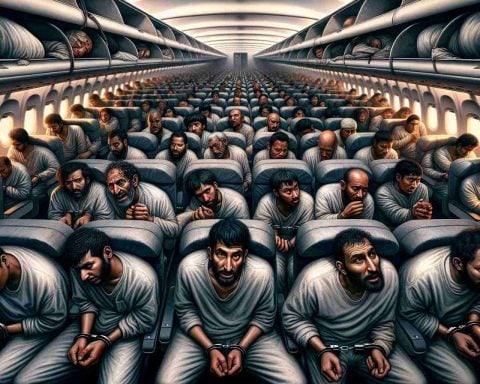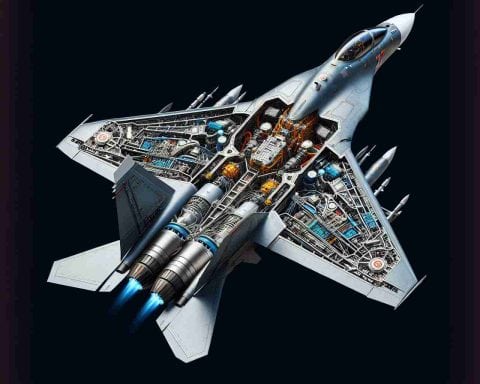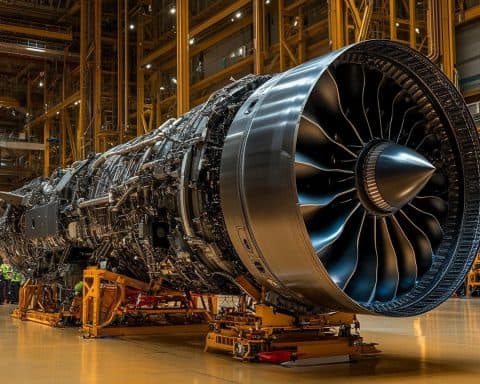- The video of 104 handcuffed Indian immigrants being deported has sparked outrage in India.
- This operation represents the largest use of military transport by the U.S. for deportation.
- The U.S. Border Patrol emphasizes strict enforcement of immigration laws, warning against illegal crossings.
- The incident raises concerns about the treatment and realities faced by deported individuals.
- This situation highlights the broader implications of U.S. immigration policies and their effectiveness.
In a dramatic turn of events, the U.S. Border Patrol recently revealed a chilling operation that has ignited outrage across India. A video surfaces showing 104 Indian immigrants, handcuffed and shackled, being boarded onto a military C-17 transport plane for their deportation back home. This gripping 24-second clip, shared on social media by the USBP Chief, highlights the stark reality of immigration enforcement.
Set against the backdrop of night, the video pulsates with rousing music, aiming to evoke a sense of national pride among viewers. The chief reinforced a stern message regarding illegal crossings, declaring, “If you cross illegally, you will be removed.” This wave of deportations marks a significant milestone for the U.S. immigration system, as it represents the most extensive use of military transport for deporting individuals.
The operation raises unsettling questions about the harsh realities faced by deportees and the lengths authorities will go to, sparking discussions about the treatment of migrants and the effectiveness of immigration policies.
As tensions rise, one thing is clear: the story of these individuals will resonate far beyond the confines of that aircraft. The takeaway? Immigration laws are being strictly enforced, and the implications for those involved remain profound.
Unpacking the U.S. Border Patrol’s Controversial Deportation Operation
Understanding the Context of the Operation
Recent revelations by the U.S. Border Patrol (USBP) about a mass deportation of Indian immigrants have sparked significant backlash not only from the Indian community but also from global observers concerned about human rights. The operation involved 104 individuals who were seen in a video being loaded onto a military C-17 transport plane, emphasizing the serious measures being implemented in immigration enforcement.
Key Features of the Operation
– Military Transport Utilization: This mass deportation marks a notable increase in the use of military aircraft for immigration enforcement in the U.S., a strategy that has raised concerns about the dehumanization of the deportation process.
– Public Messaging and Rhetoric: The USBP Chief’s remarks underscore a harsh approach to immigration enforcement, signaling a zero-tolerance policy towards illegal crossings.
Market Analysis: Immigration Policies and Their Impact
The use of military assets for deportation signals a potential shift in immigration enforcement strategies. This can be analyzed in the broader context of policy changes and public sentiment towards immigration in the U.S. The future of immigration reform may be influenced by:
– Increased Militarization: The trend towards using military resources for border control and deportations may continue, impacting public perception and policy discussions.
– Public Backlash: Growing outrage, particularly from affected communities, may lead to a demand for more humane immigration policies and practices.
Limitations and Human Rights Concerns
Critics of this operation highlight serious human rights concerns, emphasizing the potential psychological and physical impacts on deportees. The procedures followed during these deportations can often lack transparency and compassion, resulting in long-lasting trauma for the individuals involved.
Pros and Cons of Current Immigration Enforcement Practices
# Pros:
– Enhanced security and enforcement may deter illegal crossings.
– Clear messaging regarding the consequences of illegal immigration.
# Cons:
– Dehumanization of individuals during deportation processes.
– Potential violation of human rights and personal dignity.
– Negative impact on international relations, particularly with India.
Looking Ahead: Predictions and Trends
As discussions surrounding immigration reform continue, it is likely that we will see:
– Ongoing Debates: Increased public discourse regarding the ethical implications of harsh immigration policies.
– Policy Revisions: Potential changes to immigration laws that address humanitarian needs while maintaining border security.
– Innovations in Enforcement: Technology and surveillance may play an expanding role in immigration enforcement strategies.
Conclusion
The unfolding events surrounding the U.S. Border Patrol’s mass deportation operation present a complex intersection of national security, human rights, and international relations. As the global community watches closely, the wider ramifications of such actions will undoubtedly provoke ongoing dialogue about the future of immigration policies and the treatment of migrants.
For further insights on immigration policies, visit AILA.

















